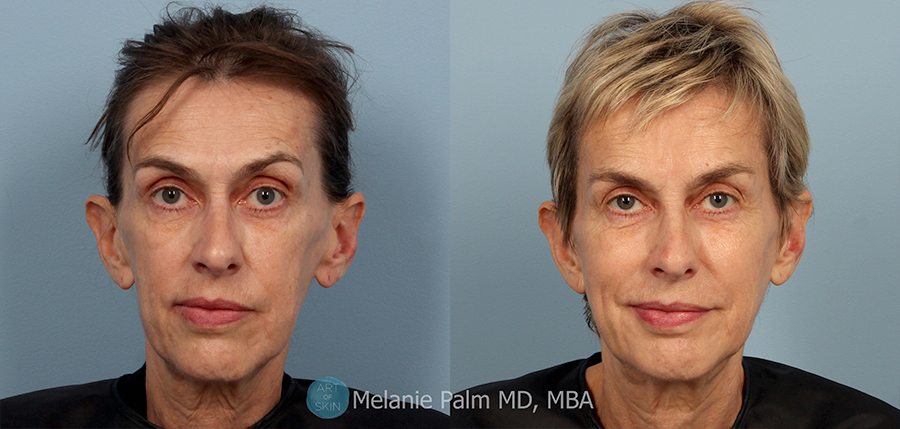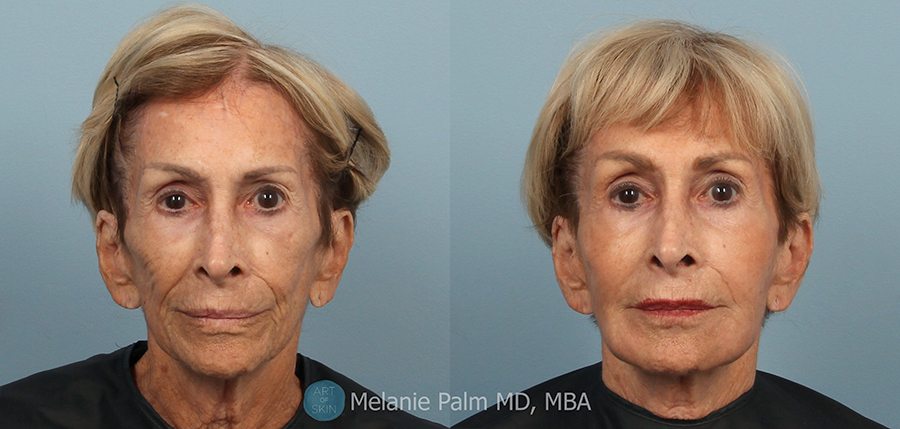Wrinkles and Volume Loss
Non-surgical Wrinkle Treatment and Filler Placement in the San Diego Area
Dr. Melanie Palm is a nationally recognized dermatologist and cosmetic surgeon specializing in artistic, thoughtful, and conservative filler and laser use for treating facial wrinkles and volume loss. Her offices are located in Solana Beach, CA just north of San Diego. Dr. Palm lectures nationally on facial rejuvenation and fillers and is a clinical investigator, speaker, and thought leader for many of the major injectables and device manufacturers. She offers many effective treatment options for enhancing the face through treatment of wrinkles and volume loss.
Facing Aging and Combating Wrinkles and Volume Loss with an Artistic, Comprehensive Approach
Wrinkles and volume loss of the face comes in all shapes and sizes because we all age differently. Genetic tendencies and environmental factors such as sun or UV exposure all shape the roadmap of facial aging.
Many of us start to notice facial changes in our late 20s to early 30s. Initial volume loss of fat and soft tissue on our face is sometimes pleasing. We lose the “baby fat” of our face and contours defined by areas of light and shadow characterize an adult female or male face. There is a sweet spot in time when facial volume is balanced by our underlying structures. However, with the passage of time and environmental exposures, shadows deepen, wrinkles form, and our face appears tired, aged, and less luminous.
Small adjustments over time can enhance our beauty and begin to suspend animation in terms of the ever-pressing passage of time. For patients who start early, preventative management of wrinkles and volume loss include light neuromodulator (Botox, Dysport) treatment, thoughtful modest filler use, and minimal downtime laser work. If patients choose treatment later in life, more significant and global aesthetic management is required. This may include full facial injectable filler and neuromodulator work, and laser or devices that require downtime or multiple treatments.
Wrinkle and volume loss on the face can be divided into various anatomic areas or issues including the following:
- Forehead and wrinkles between brows
- Crow’s feet
- Hollowing of temples
- Cheek deflation, hollowing, and volume loss
- Wrinkles on side of nose (bunny lines)
- Nasolabial folds and smile lines
- Marionette lines
- Jowl formation and loss of defined jawline
- Chin dimples, volume loss and chin crease
- Wrinkles from side sleeping
- Wrinkles and skin texture changes from sun exposure



Facial Volume Loss and Wrinkle Treatment Options
The following is an abbreviated and incomplete list of facial areas addressed by Dr. Palm and her Art of Skin MD in treating facial wrinkles and volume loss. Injectable fillers and neuromodulators may be combined with other procedures including lasers, light devices, or skin tightening treatments for a synergistic effect:
Horizontal forehead lines and wrinkles between the brows referred to as “angry 11s” or glabellar wrinkles are often treated with a neuromodulator including Botox, Dysport, or Xeomin. This provides relaxation of muscles causing the wrinkles and softens them within about 1 week and lasts approximately 3-4 months. Stubborn wrinkles and volume loss within the forehead can also be addressed by fillers. Lighter weight fillers can be used to trace and smooth lines. In the forehead, deeper placement of fillers such as Juvederm Ultra or Restylane Silk can support the forehead from underneath, softening wrinkles that may not be amenable to Botox treatment.
The first line treatment for wrinkles around the eyes often referred to as “crow’s feet” or lateral canthal lines is a neuromodulator. Botox is FDA-approved for this area, while Dysport and Xeomin can be used in a similar manner. Long-standing wrinkles that cannot be completely softened by Botox use may be further improved by careful, superficial placement of particular fillers such as Belotero, Restylane Silk, or Volbella. Crow’s feet may also be a symptom of volume loss or chronic sun damage. Volume loss can be addressed by eye rejuvenation with fillers around the eye. Long-standing crow’s feet may also be improved through laser and device treatments, most commonly CO2 laser resurfacing and ResurFX.
Volume loss occurs all over the face with time but in some individuals the temples may become scooped out or hollowed. This concave appearance can be improved with proper filler placement. Many injectables are used in this area. Sculptra, a longer term injectable that produces collagen, is FDA-approved in this region in some patients. Many hyaluronic acid filler products are also helpful in this region including Voluma, Juvederm, and Restylane Lyft. It is important to note that male and female temples are not created equally. While men can have a fuller, more pronounced temple, women typically should have a neutrally-filled temple to one that is just slightly concave. It is important to note these gender differences in restoring proper facial balance in patients.
Over time, fat, soft tissue, and bone loss in the midface causes deflation of the cheeks and hollowing in the midface creating exaggerated shadows. The cheeks become less full, and midface volume loss causes deepening of other facial wrinkles such as the nasolabial folds. Structural rebuilding and volume replacement are the mainstays of treatment for cheek volume loss and hollowing of this area. Voluma, Restylane® Lyft, Radiesse, and Sculptra are the most commonly used injectable fillers used for facial balancing in the midface, although other fillers may be used depending on individual facial characteristics.
Crinkling on the side of the nose commonly results in wrinkles referred to as “bunny lines.” These wrinkles are caused by the nasalis muscle on the nose. Softening of these wrinkles is possible with neuromodulators such as Botox, Dysport or Xeomin. This is commonly done in conjunction with treatment of other areas commonly treated with Botox such as the forehead, crow’s feet, and between the brows.
Nasolabial folds and smile lines refer to the wrinkles or folds that occur between the sides of our nose and mouth. These deepen over time as we experience midface volume loss and also due to bone loss to the platform that supports our nose. Proper cheek volume support with fillers improves many nasolabial folds. Nasolabial folds, especially the upper portion near the nose may be treated lightly with fillers. However, nasolabial folds should not be completely removed. This creates a “monkey-like” look referred to as simian lip. Many fillers can be used in the midface and nasolabial fold and smile line region to soften their depth, and rejuvenate the face. These include collagen stimulators such as Sculptra, and many hyaluronic acid fillers from the Juvederm and Restylane family of products.
Marionette lines are folds that occur in the lower face as wrinkles from the corners of the mouth down to jawline resembling a puppet or marionette. They give the impression of a patient appearing sad and unhappy. Volume loss, bone support, and even dentition (our teeth) play a role in their formation. To improve the appearance of the marionette area, fillers are often used to support and smooth marionette lines. Fillers appropriate for this area include Juvederm, Restylane Defyne, Radiesse, Sculptra, and for very early folds, Vollure. Instalift, an absorble suture placed underneath the skin, can provide lifting of the lower face which may also improve the appearance of marionette lines. Fine lines at the corners of the mouth associated with the marionette area can be treated with lighter fillers such as Restylane Silk, Volbella, and Belotero.
Volume loss over time in the lower half of the face leads to the formation of jowls or fullness along the jawline just beyond the chin. Furthermore, bone loss of the jawbone (mandible) over time causes a loss of definition along the jawline. Skin tightening and lifting procedures are often combined with volume and support restoration in the lower face to reverse these changes. Ultherapy is an ultrasound-based device that lifts skin along the lower cheeks and jawline to improve the appearance of this area over a period of months. Instalift, an absorbable suture, can also be placed in the lower face, to produce an instantaneous improvement of the jawline that continues to improve over 6-12 months. Furthermore, more robust fillers may be used to support bone loss along the jawline over time. Radiesse, Sculptra, Voluma, Restylane Lyft and Juvederm are excellent choices for volume restoration to the jawline area.
Aging changes around the chin or inadequate chin volume or bony support can result in a variety of changes. These include development of a chin wrinkle (or mental crease), and orange peel texture to the chin skin called p’eau d’orange due to increased muscle tone of the chin. The orange peel appearance can be greatly improved by both relaxing the mentalis chin muscle with Botox or Dysport and by supporting the chin with volume replacement through injectable fillers. Voluma, Restylane Lyft, Restylane, Radiesse, and Juvederm may all be used to enhance the appearance of the chin. Small wrinkles around the chin or of the chin crease can be improved with lighter fillers such as Belotero, Vollure, Volbella, and Restylane Silk.
Side sleeping results in wrinkles and creases of the face, typically as vertically oriented wrinkles on the cheeks, in the brow, and along the sides of the forehead. Prevention of these wrinkles is key, with back sleeping favored to side sleeping. However, these etched wrinkles can be improved with fillers such as Belotero, Restylane Silk, and Vollure.
Significant sun or UV exposure results in breakdown of collagen and elastin in the skin as well as discoloration. Severe waxy skin changes and wrinkling related to chronic sun exposure is often referred to as dermatoheliosis and is often treated with a combination of topical retinoids and sunscreens in addition to laser skin resurfacing such as ResurFX or CO2 laser resurfacing. Once the skin envelope is repaired with these procedures, injectable fillers may be used with better duration to restore lost facial volume related to chronic UV exposure.
Facial volume loss and wrinkle treatment options include injectable fillers, neuromodulators, light and laser devices, and skin tightening devices depending on the individual and the area of facial concern. At Art of Skin MD, individual treatment plans are developed to achieve natural and rejuvenating effects on the skin.
If you are interested in learning more about wrinkle treatment options and how to eliminate facial volume loss, or would like to set up a consultation, call Dr. Melanie Palm at 858.792.SKIN (7546) to schedule your appointment.

